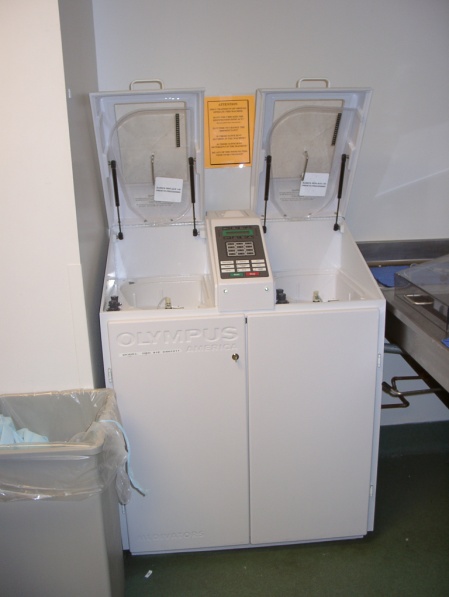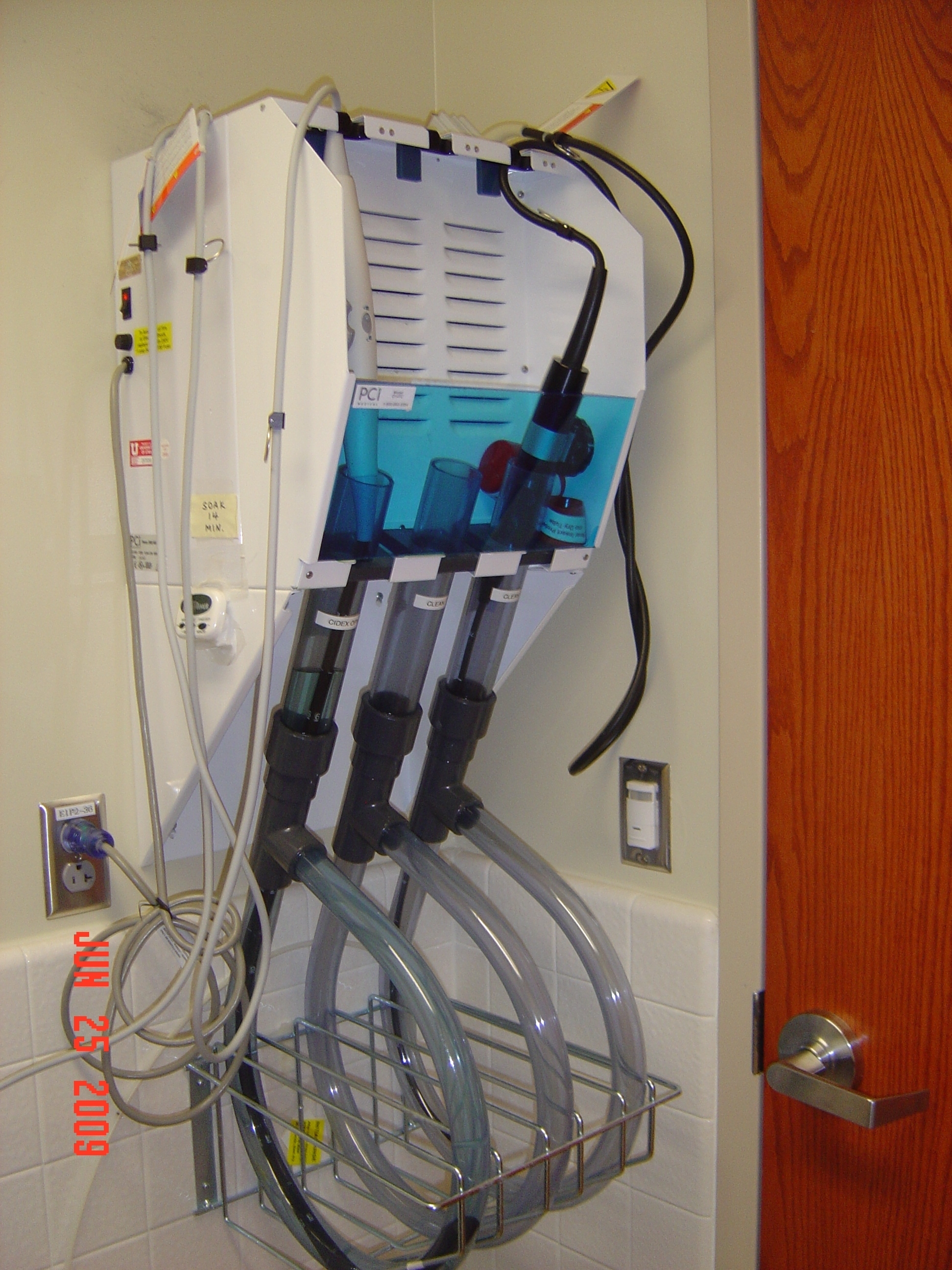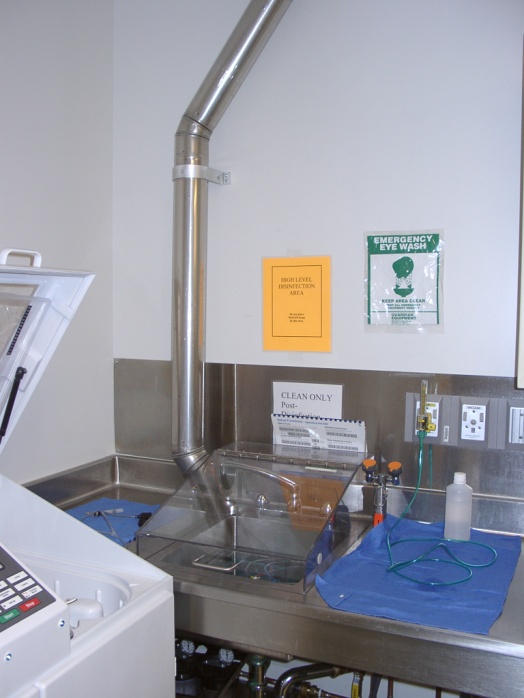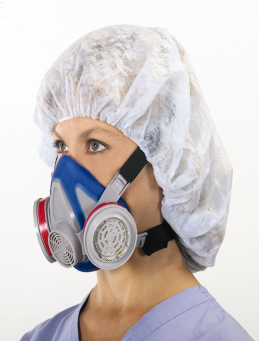7 High Level Disinfectants
Survey of Healthcare Workers' Health and Safety Practices
Attachment I6_Module E_TC
Secondary Hazard Module
OMB: 0920-0860
MODULE E: High Level Disinfectants Form Approved
7/23/10 OMB No. 10AP-xxxx
Expiration Date: xx/xx/2011
PROGRAMMING INSTRUCTIONS APPEAR IN BLUE.
|
|
|
|
||||||||||||||
|
|
During your career, how long have you been disinfecting medical instruments and other items using HIGH LEVEL DISINFECTANTS?
High level disinfectants, include: .
|
|
|
|
|
||||||||||||
|
|
|
|
||||||||||||||
|
|
When was the last time you received training on the safe handling of high level disinfectants?
|
|
|
|
|
||||||||||||
If you work for more than one employer, the following questions apply to your primary employer, i.e., the one for which you typically work the most hours. If you are self-employed, consider yourself the employer.
|
|
|
|
||||||||||||||
|
|
Does your employer have standard procedures for using high level disinfectants?
|
|
|
|
|
||||||||||||
|
|
|
|
||||||||||||||
|
|
During the past 7 calendar days, on how many days did you disinfect medical instruments or other items using high level disinfectants? (Count a partial day as one day.)
display calendar highlighting the past 7 calendar days. Applies to all questions with ‘in the past 7 calendar days’ |
|
|
|
|
||||||||||||
|
|
|
|
||||||||||||||
|
|
During the past 7 calendar days, how much total time did you spend handling or working with high level disinfectants?
Note: Include only the time you spent actually loading and unloading the processing unit or tray; testing, adding and replacing the disinfectant solution; and cleaning the disinfecting process units or trays.
|
|
|
|
|
||||||||||||
|
|
|
|
||||||||||||||
|
|
During the past 7 calendar days, did you handle high level disinfectants...
|
|
|
|
|
||||||||||||
|
|
During the past 7 calendar days, how many medical instruments (e.g., endoscopes, probes) did you disinfect using high level disinfectants?
|
|
|
|
|
||||||||||||
|
|
|
|
||||||||||||||
|
|
During the past 7 calendar days, which of the following high level disinfectants did you use for disinfecting medical instruments and other items?
Please all that apply.
|
|
|
|
|
||||||||||||
If only one marked in Question 8 Go to Question 10. |
|
|
|
||||||||||||||
|
|
|
|
||||||||||||||
|
|
Of the high level disinfectants you checked above, please select the one most often used during the past 7 calendar days. |
list the HLDs marked in Question 8 (use radio buttons) |
|
|
|
||||||||||||
|
|
|
|
||||||||||||||
|
|
Which
of the following disinfection
systems did you use during the past 7
calendar days?
Please all that apply.
|
|
|
|
|
||||||||||||
|
|
|
|
||||||||||||||
|
|
Local Exhaust Ventilation (LEV) captures and removes high level disinfectant vapors at the point where they are being produced (i.e., inside disinfection machine). Includes an air vent hose or duct from machine to an external exhaust source).
|
|
|
|
|||||||||||||
If ’automated’ ONLY in Question 10 Go to Question 13 |
|
|
|
||||||||||||||
|
|
|
|
||||||||||||||
|
|
Which of the following statements best describes the ventilation for the MANUAL disinfection system (e.g., tray, container or disinfection station) you used most often during the past 7 calendar days?
Note: Local Exhaust Ventilation (LEV) captures and removes high level disinfectant vapors at the point where they are being produced.
Examples include: a ventilated enclosure above a sink containing disinfection solution (left photo); a probe disinfection station with built-in exhaust vents for removing vapors (right photo)
|
|
|
|
|
|
|||||||||||
|
|
|
|
||||||||||||||
|
|
During the past 7 calendar days, did you manually pour fresh or new high level disinfectant(s) into trays or reprocessing units? |
|
|
|
|||||||||||||
|
|
|
|
||||||||||||||
|
|
During the past 7 calendar days, what was the total amount of high level disinfectant(s) you manually poured into trays or reprocessing units?
|
|
|
||||||||||||||
|
|
|
|
||||||||||||||
|
|
During the past 7 calendar days, did you manually drain high level disinfectant(s) from trays or reprocessing units?
|
|
|
||||||||||||||
|
|
|
|
||||||||||||||
|
|
During the past 7 calendar days, how many spills occurred while you were handling high level disinfectants?
|
No spills |
1-2 spills |
3-5 spills |
More than 5 spills |
|
|
|
|||||||||
|
|
|
|
|
|
|
|
||||||||||
|
|
|
|
|
|
|
|
||||||||||
|
|
|
|
||||||||||||||
If ’No spills’ marked in BOTH Questions 16a and 16b Go to Question 20. Otherwise Go to Question 17. |
|
|
|
||||||||||||||
|
|
|
|
||||||||||||||
|
|
How often was/were the spill(s) cleaned up? |
|
|
|
|
|
|||||||||||
|
|
|
|
||||||||||||||
|
|
How often did you yourself clean up the spill? |
|
|
|
|
|
|||||||||||
|
|
|
|
||||||||||||||
|
|
Who cleaned up the spill(s)?
Please all that apply.
|
|
|
|
|
|
|||||||||||
|
|
|
|
||||||||||||||
|
|
Are hazardous chemical spill kits readily available? |
|
|
|
|
|
|||||||||||
|
|
|
|
||||||||||||||
|
|
During the past 7 calendar days, did your skin come into direct contact with high level disinfectant(s)?
|
|
|
|
|
|
|||||||||||
Questions addressing work practices and use of personal protective equipment (PPE) will help us understand what is currently used and under what circumstances. Depending on your job and exposures, PPE may not be required.
|
|
|
|
||||||||||||||
|
|
During the past 7 calendar days, how often did you wear a water resistant gown or outer garment while handling high level disinfectants?
|
|
|
||||||||||||||
|
|
|
|
||||||||||||||
|
|
What were the reason(s) you did not always wear a water resistant gown or outer garment while handling high level disinfectants?
Please all that apply.
|
|
|
|
|||||||||||||
If only one reason marked in Question 23 Go to Question 25. |
|
|
|
||||||||||||||
|
|
Of the reasons you checked above, please indicate the most important reason you did not always wear a water resistant gown or outer garment while handling high level disinfectants. |
list reasons marked in Question 23 (USE RADIO BUTTONS) |
|
|
|
||||||||||||
|
|
|
|
||||||||||||||
|
|
In your current job, have you taken home any clothing that came into contact with high level disinfectants? |
|
|
|
|
||||||||||||
|
|
|
|
||||||||||||||
|
|
During the past 7 calendar days, how often did you wear protective gloves while handling high level disinfectants?
|
|
|
|
|||||||||||||
|
|
|
|
||||||||||||||
|
|
What were the reason(s) you did not always wear protective gloves while handling high level disinfectants?
Please all that apply.
|
|
|
|
|||||||||||||
If only one reason marked in Question 27 Go to Question 29. |
|
|
|
||||||||||||||
|
|
Of the reasons you checked above, please indicate the most important reason you did not always wear protective gloves while handling high level disinfectants. |
list reasons MARKED in Question 27 (USE RADIO BUTTONS) |
|
|
|
||||||||||||
|
|
|
|
||||||||||||||
|
|
During the past 7 calendar days, how often did you wear eye or face protection (e.g., goggles, face shield) while handling high level disinfectants? Do not include personal eyeglasses
|
|
|
|
|||||||||||||
|
|
|
|
||||||||||||||
|
|
What were the reason(s) you did not always wear eye or face protection while handling high level disinfectants? Please all that apply.
|
|
___________________________ |
|
|||||||||||||
If only one reason marked in Question 30 Go to Question 32. |
|
|
|
||||||||||||||
|
|
Of the reasons you checked above, please indicate the most important reason you did not always wear eye or face protection while handling high level disinfectants. |
list reasons marked in Question 30 (USE RADIO BUTTONS) |
|
|
|
||||||||||||
|
|
|
|
||||||||||||||
|
|
During the past 7 calendar days, did you wear any of the following while handling high level disinfectants? Please all that apply.
|
|
|
|
|||||||||||||
|
|
|
|
|
|
||||||||||||
|
|
Photo will be included |
|
|
|
||||||||||||
|
|
|
|
|
|
|
|||||||||||
DISPLAY FOLLOWING NOTE ON A SEPARATE SCREEN (except those who mark ‘i don’t know’): THE FOLLOWING QUESTIONs ASK ABOUT RESPIRATORS. STANDARD SURGICAL MASKS ARE NOT RESPIRATORS.
IF RESPONDENT MARKED ‘HALF-FACEPIECE AIR PURIFYING RESPIRATOR’ OR ‘FULL-FACEPIECE AIR PURIFYING RESPIRATOR’ IN QUESTION 32 GO to Question 33.
IF RESPONDENT MARKED ONLY ‘STANDARD SURGICAL MASK’ OR ‘NONE OF THE ABOVE’ IN QUESTION 32 GO to Question 34.
If respondent marked ‘I don’t know’ in question 32 GO to Question 37
|
|
|
|
||||||||||||||
|
|
How often did you wear a half-facepiece respirator or a full-facepiece air purifying respirator while handling high level disinfectants? |
|
|
|
|
|
|||||||||||
|
|
|
|
||||||||||||||
|
|
What were the reason(s) you did not always wear a half-facepiece air purifying respirator with chemical cartridge or a full-facepiece air purifying respirator with chemical cartridge while handling high level disinfectants? Please all that apply. |
|
|
|
|
|
|||||||||||
If RESPONDENT marked more than one reason in Question 34 Go to Question 35. Otherwise, Go to INSTRUCTIONS BEFORE Question 36 |
|
|
|
||||||||||||||
|
|
|
|
||||||||||||||
|
|
Of the reasons you checked above, please indicate the most important reason you did not always wear a respirator while handling high level disinfectants. |
list reasons marked in Question 34 (USE RADIO BUTTONS) |
|
|
|||
If Respondent marked “Half-facepiece respirator” or “Full-facepiece respirator” in Question 32 Go to Question 36. Otherwise Go to Question 37. |
|||
|
|||
|
|
Have you been fit-tested by an occupational health and safety specialist for the respirator(s) you use for high level disinfectants? |
|
|
|
|||
|
|
Has exposure monitoring (using badges or other sampling devices) been conducted in the past 12 months to assess your or your co-workers’ exposure to high level disinfectants?
|
|
all responses: if this is the first hazard module completed Go to Core Module If this is the second hazard module completed, end survey. end with ‘Thank you’ statement. |
|
|||
|
|
Which of the following high level disinfectants were included in the exposure monitoring?
Please all that apply. |
|
All responses Go to Core Module, except when this is the 2nd hazard module completed, then end with ‘Thank you’ statement. |
Thank you for participating in the NIOSH Health and Safety Practices Survey of Healthcare Workers. Your answers have been submitted.
Public reporting burden of this collection of information is estimated to average 11 minutes per response, including the time for reviewing instructions, searching existing data sources, gathering and maintaining the data needed, and completing and reviewing the collection of information. An agency may not conduct or sponsor, and a person is not required to respond to a collection of information unless it displays a currently valid OMB control number. Send comments regarding this burden estimate or any other aspect of this collection of information, including suggestions for reducing this burden to CDC/ATSDR Reports Clearance Officer, 1600 Clifton Road NE, MS D-74, Atlanta, Georgia 30329-4018; ATTN: PRA (10AP-xxxx).
| File Type | application/vnd.openxmlformats-officedocument.wordprocessingml.document |
| File Title | Please respond to the following questions by checking the box next to your answer choice |
| Author | Marci Treece |
| File Modified | 0000-00-00 |
| File Created | 2021-02-02 |
© 2025 OMB.report | Privacy Policy





